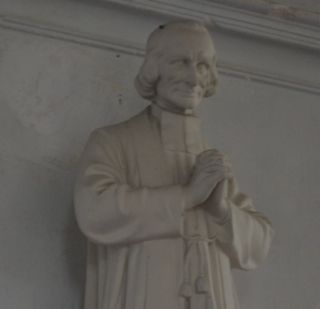Seven churches visited, 237 to go! Where was this manic church building coming from in the twelfth century, I keep asking myself. There are many explanations.
One is that many people thought the world would collapse in the year 1000, after a reference to this in the Apocalypse written by St John. When that didn’t happen, people assumed John had meant 1000 years after the death (resurrection) of Jesus, assumed to be in the year 33. But 1033 passed and the world survived. So people started to get their act together, rejected the defeatism of the past, started to hope again, and with hope started to build churches.
Another explanation is purely economical. This was the period when there was a kind of agricultural revolution. New methods to use land were being developed. Not growing the same crops over and over again, but changing crops over different parcels of land and sometimes just leaving a field bare. Production went up and when the economic standards improve, this has a positive impact on cultural life, as Marx explained. Building churches was the natural result.
And then there are the political explanations. The centuries before were pretty wild, with Vikings plundering as far as Burgundy, the Magyars coming from Hungary and a whole lot of tribes more.
During the 11th century most of these tribes were Christianized and the world became relatively peaceful. That was a good time to start building churches.
Well, whatever the exact reason, it happened, and definitely in the Cluny area. They were well built too, that’s why they can survive till today. The builders supposedly came from Lombardy. The Lombards were a German tribe, that’s why the northern part of Italy is part of North West Europe and the Southern part of South Italy, I realised one of these days.
And they’re charming. Small cosy places for 100 people at the most. It’s still way to large for the communities that they serve. French have never been very keen on going to church, I seem to remember, preferring to enter church three times in life, with baptism, communion, marriage and one time just after death. But now not even that is keeping these churches going anymore. More then ten of these churches share their services, the sunday stroll to church has become quite a journey.
One of the most hilarious things in these churches is the old preaching chairs. They used to be raised and were only accessible with a little staircase. In most churches these staircases have been removed, which gives the impression of some very athletic priests that can jump at least 3 metres before they can give their own vision of the world.
Another thing I like is that there are a lot of statues of the Pastor of Ars, a sympathetic priest from the early nineteenth century. Ars is a little town a little southwest from here. The priest, his real name is Jean-Marie Viennay. He was born around the French revolution and made priest in this tiny town Ars, east of Villefranche sur Saone. There were 23- people in the town, but at his first mass there were only two visitors in the church. But gradually he became popular, so popular that a few times when the priest was ‘promoted’ to a larger parish, the people from Ars just refused to let him go.
The statues are all very similar. A very tiny man with cheeks as if he hadn’t eaten for years, which was probably true, because he preached scarcity, but also a lot of common sense and most of all that one shouldn’t complain too much, which I do agree with.
My grandma’s brother Bernard had one of these statues. Later it was given to my uncle Mari, I remember it being high up against one of the trunks that held his farmhouse up. No idea what has happened with it. But I do like to see him over and over here in these wonderful churches. Maybe Julie can carve one too?
12 oct

Share


Leave a Reply